|
HUMANGEAR CAPCAP
TEST SERIES BY DAVID TAGNANI
LONG-TERM REPORT
October 13, 2008
CLICK HERE TO SKIP TO THE FIELD REPORT
CLICK HERE TO SKIP TO THE LONG-TERM REPORT
TESTER INFORMATION
|
NAME:
|
David Tagnani
|
|
EMAIL:
|
dtagnani@hotmail.com
|
|
AGE:
|
32
|
|
LOCATION:
|
Spokane, Washington
|
|
GENDER:
|
m
|
|
HEIGHT:
|
5' 10" (1.78 m)
|
|
WEIGHT:
|
160 lb (72.60 kg)
|
Backpacking Background: I have been camping and hiking for as long as I can remember, but I've really only been backpacking for ten years or so. I started off in the hills of northeastern and central Pennsylvania, have hiked trails from Maine to Georgia, and now I am exploring the incredible terrain of the inland northwest. I seldom do trips longer than three days, with most trips being overnighters. I do not own crampons, an ice axe, or a climbing harness, so if the route is technical enough to require them, you won't find me there. I simply like to walk in the woods.
INITIAL REPORT
PRODUCT INFORMATION & SPECIFICATIONS
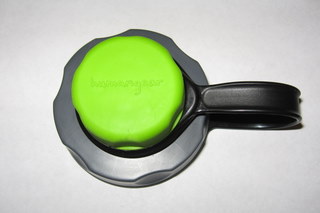
Manufacturer: humangear
Year of Manufacture: 2008
Manufacturer's Website: humangear.com
MSRP: $5.95 US
Listed Weight: Unavailable
Measured Weight: 1.5 oz (42.5 g)
Color: Gray / Green
Materials: #5 Polypropylene (BPA-free and Polycarbonate-free)
Spout width: 1.125 in (28.58 mm)
The capCAP is the first product from the new company humangear. As their name implies, they claim to strive for more user-friendly products.
As far as the capCAP goes, the goal was to make a cap that maintained the advantages of the wide-mouth opening (easy cleaning, filtering water, etc.) but made it easier to drink from without spilling.
Some of the features claimed to make capCAP superior to the standard lids include:
- small spout that is easy to drink from (non-spill, room for your nose)
- large screw-off cap for cleaning and filling / filtering
- easy-to-grip rubberized cap
- rounded, more comfortable strap
The capCAP is designed to fit many popular bottles with wide-mouth openings, including:
- Nalgene 1L (32 oz) (HDPE, Tritan, PC)
- Nalgene Everyday / OTG
- Nalgene SS
- All CamelBak
- Cyclone
- Guyot SS
- Stansport 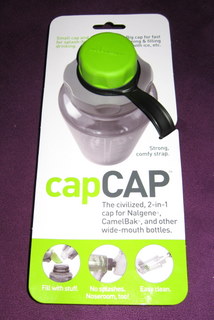 | | Packaging |
INITIAL IMPRESSIONS
The capCAP arrived screwed onto a simple cardboard jacket, seen at right. The front of the packaging touts the capCAP's three main features: a wide opening, a narrow opening, and a more comfortable strap. The back of the packaging lists the bottle brands with which the capCAP is compatible. Also on the back are concise installation instructions. As might be expected for such a basic product, the instructions are clear and simple. Two small pictures adequately illustrate the installation process.
As I unscrewed the capCAP from the cardboard packaging, I was immediately struck by the green rubber on the smaller cap. This material is indeed easy to grip, almost "sticky." The larger cap is a smoother, harder plastic, but the edge is scalloped to aid operation. This larger cap will be used much less frequently, so the grip is less important.
The capCAP feels solid and well-constructed; it bends only very slightly when squeezed with the full force of one of my hands. Of course, solid means heavy. Indeed, the capCAP weighs 1.5 ounces (42.5 grams), which is a full ounce (28 grams) heavier than the cap that came with my Nalgene bottle. I suppose that is small price to pay if the product is worth it.
TRYING IT OUT
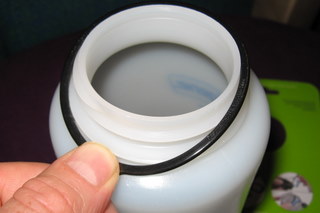 | | Installing the capCAP |
I own a standard, white, 32 oz. HDPE wide-mouth Nalgene bottle. Referring to the instructions on the back of the packaging, I installed the capCAP with no problems. Snapping the plastic ring onto the top of the Nalgene bottle, as seen at right, required some effort and pressure. But to me, this just means that the strap is secure.
Next, I screwed on the capCAP. I noticed that it worked smoothly and fit tight, just like it had been an original Nalgene part. Both the small, green cap and the large, grey cap feel comfortable and are easy to grip. I put on my fleece mittens to see how cold-weather operation might work, and the capCAP performed well. The rubberized green cap is extremely easy to gip even with the mittens. No problem at all. The rubber material reminds me of the nosepads and temple grips on high-end sunglasses. The larger grey lid is less easy to operate with mittens, but was not much of a problem either.
Next, I filled the bottle with water to give it the leak test. I shook it, rolled it, turned it upside down . . . 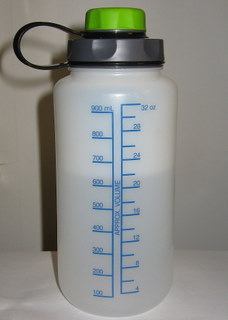 nothing could cause the capCAP to give up even a drop of water. This is a good sign, because humangear's claim that the capCAP fits all different types of bottles caused me to question whether it would really fit any one bottle perfectly. But I can say that in regards to Nalgene bottles, it fits as perfectly as the original lid. nothing could cause the capCAP to give up even a drop of water. This is a good sign, because humangear's claim that the capCAP fits all different types of bottles caused me to question whether it would really fit any one bottle perfectly. But I can say that in regards to Nalgene bottles, it fits as perfectly as the original lid.
Drinking from the capCAP's smaller spout produced some ambivalence in me. It is nearly impossible to drink from wide-mouth bottles while on the move without drooling all over yourself. The capCAP solves this problem. I am able to quite easily walk and drink at the same time without spilling a drop. But while it is much easier to drink without spilling or drooling, there is a bit of a problem with air displacement. Because my lips easily wrap around the entire opening, there is no way for air to displace the water I'm drinking. And because the Nalgene bottle is solid, it will not simply collapse like disposable beverage containers. That means that I must leave a gap with my lips to allow air to enter the bottle as I drink. This is a bit awkward. Perhaps I will get used to it as time goes by, but for now, it is a bit annoying.
Two of the capCAP's touted features seem to me like solutions to nonexistent problems. The first is the fact that the capCAP makes room for your nose while you drink. Hmmm. I don't recall this ever being a problem. But when I take a sip from my Nalgene bottle, lo and behold, my nose does hit the upper edge of the opening. But if I never really took notice before, is this really a problem? The second feature that I feel is a solution to a nonexistent problem is the rounded, more comfortable strap (see picture at right). Hmmm. Is 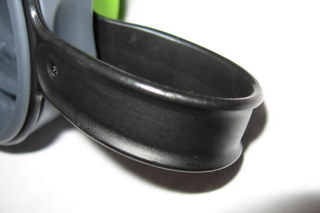 | | Detail of rounded strap |
the standard Nalgene strap squared off and uncomfortable? When I compare the capCAP's strap with the standard Nalgene lid's strap, I do see a significant difference. The standard lid comes with a strap that is squared off at the edges and noticeably rougher than the capCAP's thick, smooth, rounded edges. But again, I never noticed the standard strap causing any discomfort before, so is this really a problem? Maybe if I regularly carried my bottle in my hand for long periods of time, this might be a nice feature. But my bottle is always in my pack, so the problem is nonexistent.
TESTING STRATEGY
Field conditions may be less important in this test than usual, but below are the anticipated conditions in which I will be using the capCAP in the next few months.
Day Hiking:
I hike and fish several times per week in Riverside State Park along the Spokane River. The many trails here generally involve little elevation gain or loss and are on wide, well-groomed trails, though there are a few sections that cross basalt talus slopes. I tend to do some scrambling as well, up and down the riverbank to reach the water if I'm fishing.
Backpacking Trips:
Central / North Cascades:
The trails I've got my eye on (in the Icicle Creek drainage and Teanaway River drainage) begin in cool, dense forest and gain serious elevation in order to attain a pass or a peak. Crossing creeks and rivers is also a typical feature of hikes here, Conditions vary, of course, but typical elevation is anywhere from 3500 feet (1067 meters) to 8000 feet (2438 meters) with temperatures averaging from lows around 50 F (10 C) to highs around 85 F (29 C). I usually cover about 10 miles (16 kilometer) per day.
Eagle Cap Wilderness: mid July.
This trip is still in the works, but we anticipate spending four days exploring this amazing wilderness area in northeastern Oregon. One particular route we are considering would take us from a starting elevation of 5200 feet (1585 meters) up to 8000 feet (2438 meters) at the terminus in about 19 miles (31 kilometers). The weather conditions should be a bit hotter and dryer than conditions in the Cascades.
Beyond these trips and the aforementioned excursions at Riverside State Park, there will be several overnight backpacking trips that have not yet been finalized or even conceived of yet. I hike several times a week, usually in the hot and dry Selkirk mountains of Eastern Washington and North Idaho. Elevation gain can be up to 3000 feet (914 meters) per day, with temperatures ranging from 50 F (10 C) to 95 F (35 C).
CONCLUSION
The capCAP is a solid, well-made product that lives up to its claims. But for me, most of the problems it claims to address don't exist. Since I usually rely on a water bladder for on-the-move hydration, the capCAP is unnecessary weight in my pack. We'll see how the capCAP holds up to use and abuse in the field, and if it holds any unexpected surprises. Maybe I'll grow fonder; maybe I won't.
This concludes my Initial Report. The Long-Term Report will be amended to this report in approximately three months from the date of this report. Please check back then for further information.
David Tagnani
LONG-TERM REPORT
LONG-TERM TEST LOCATIONS AND CONDITIONS
In the three months since I received the capCAP, I have used it daily. I installed it on my everyday water bottle (Nalgene), so it has seen a lot of use during the testing period. It accompanied me to the jobsite during the summer and to school during the fall. During the hot summer months, I would leave my Nalgene bottle with the capCAP in the freezer overnight so I could have cold water throughout the following day. So, the capCAP has been through several dozen freeze/thaw cycles.
I have had it camping more times than I can count, but two of the more memorable trips were in the Teanaway River valley in the Cascade mountains where we camped at elevations around 2400 feet (730 meters) and hiked to elevations near 6200 feet (1890 meters). I also spent a few days in Mount Rainier National Park and in the Selkirk mountains near the Idaho/Montana border.
PERFORMANCE IN THE FIELD
Despite some initial reservations, I have become quite fond of this little product.
It has held up quite well in the field. It has never leaked or failed in any way. No noticeable signs of wear, either. The only thing negative that I can think to say about it is that the soft green rubber on the smaller cap is so grippy that it grips dirt really well. I can't get it off, either. But, who cares? This is a piece of camping equipment and this is merely an aesthetic issue.
I do not own a dishwasher, so it has been washed by hand using a nylon brush. While I could not get the discoloration from the dirt off of the green part, I did not see any noticeable wear from being washed and scrubbed, either.
In my IR, I mentioned a slight problem with air displacement. I must have gotten used to the capCAP, because it is no longer an issue. I instinctively leave a small gap to allow air to enter, but I can still comfortably drink while on the move without spilling or drooling.
Oh yeah, here is one small annoyance. Sometimes when I want to screw off only the green cap, the grey cap will come off with it. That is simply the result of closing the green lid too tight or not closing the grey lid tight enough. I quickly discovered an easy solution to that problem: put a little extra oomph into tightening the grey lid, but be more gentle when closing the green lid. This causes the grey lid to stay put when I am trying to open the green lid.
SUMMARY
This is a useful and convenient little product. It definitely lives up to its claims as a more user-friendly update to the stock Nalgene lid. The price is a sticking point for me, since it costs as much as the bottle itself. But now that I have it, I plan to keep it on my bottle for the foreseeable future. I can't think of a reason why I would revert back to the stock lid. For a little more weight, it is quite a big improvement.
Thanks to humangear and BGT for the opportunity to test the capCAP.
Dave Tagnani
This report was created with the BackpackGearTest.org Report Writer Version 1.
Copyright 2008. All rights reserved.
Read more reviews of Humangear gear
Read more gear reviews by David Tagnani
|




